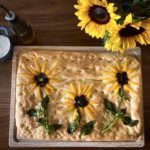
My 2-year-old son has a serious pickle problem. He will eat half a jar in one sitting if I let him. Being the son of a chef, he has expensive taste; his favorite pickles from Lake Meadow Naturals run about $9 a jar. So we have started making our own, which is admittedly part family-bonding time, part money-saving venture. I think I’ve created a very similar recipe for a fraction of the cost.
These are refrigerator pickles, meaning no actual canning knowledge or equipment is necessary. You don’t even need to actually cook anything. Simply prepare the brine, chop a few ingredients, and let the pickling commence! This makes one large quart-sized mason jar full of pickles or two pint-sized jars. These are essentially bread and butter pickles. They’re sweet and sour, with a few spices for added flavor. If you’re not into sweet pickles, you can omit the sugar and add some dill for a more traditional sour pickle. Did you know the term “bread and butter pickles” comes from a couple who invented them in the 1920s and bartered their pickles for grocery staples like bread and butter?
Almost every culture in the world has a unique version of a pickle with a wide array of ingredients. There’s sauerkraut from Germany, kimchi from Korea, cornichons from France, pickled daikon from Japan, giardiniera from Italy, preserved lemons from Morocco, pickled herring from Sweden, pickled mango from India, or the classic American dill pickle. Why stop at cucumbers? This brine works well for red onion, with which I like to top onto my avocado toast. I also like this as a pickled cabbage, which works nicely with a fried fish taco.

We know that cultures have used pickling for centuries as a means to preserve foods, but what actually is happening in that jar? How does a cucumber become a pickle? Pickling involves covering a food in an acidic brine. Acid is key to transforming the flavor. Fermentation never adds acid, although sometimes it leaves a sour flavor after the good bacteria have worked through the sugars. Use pickle-making as a science lesson for your kids. FATTOM is an acronym used to outline the conditions for bacterial growth, which is what we are trying to inhibit with the pickling process. F is for food, the object getting pickled. A is for acid, the vinegar in the brine. T is for time, the two days it takes to pickle the cucumbers in the fridge. The second T is for temperature, which is being controlled by the refrigerator. O is for oxygen, which isn’t present in the jar because of the seal. M is for moisture, which is controlled by the amount of water and vinegar in the brine. Who knew pickles could save you money and teach your kids about science and history?
Sweet and Spicy Refrigerator Pickles (Recipe makes 1 quart-sized mason jar)
4 mini cucumbers (Kirby) or 1-2 regular-sized cucumbers (sliced to your desired thickness)
1 cup apple cider vinegar
½-cup water
½-cup sugar
1 tablespoon salt
1 teaspoon black peppercorns
1-2 cloves of garlic, chopped
1 tablespoon whole mustard seeds
Pinch of turmeric (optional for color)
Pinch of red pepper flakes (optional for added heat)
Instructions
- Prepare the brine by combining the water and vinegar with the sugar and salt. Whisk well until all solids have dissolved.
- Chop cucumbers into spears or coins. Whichever shape you choose, make sure they are of even thickness. You may use a mandolin to ensure uniformity.
- Add spices to the brine. Fill the mason jar with the cucumbers first, leaving about an inch open near the top.
- Fill the jar with brine.
- Cover the mason jar with the lid and place in the refrigerator. After two days, you have pickles. Pickles will last about 2-3 months in the refrigerator.



Thank you for the pickle recipe. I use to help my Mother make pickles but did not think about it until I read your article. My niece who is 10 and I will make these soon. Please share some other recipes too.
My niece would love to come to a class if you decided to have one for youth.
Thank you